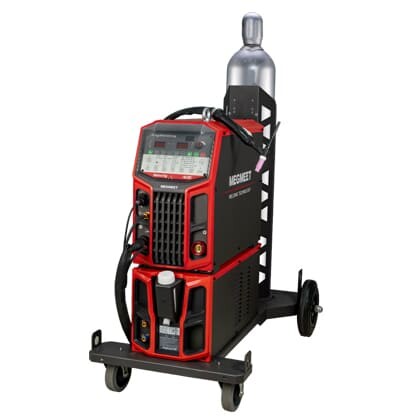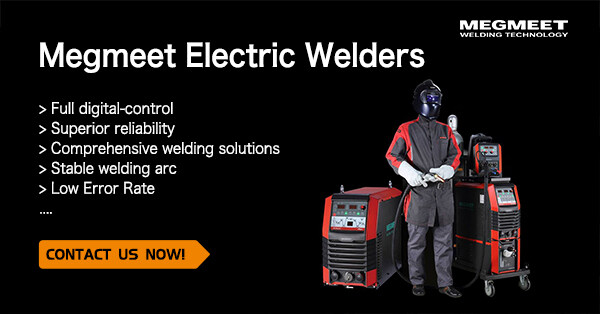TIG welding is a versatile and precise welding method that can be used to join different metals, such as steel, aluminum, or stainless steel. TIG welding uses a tungsten electrode to create an electric arc that melts the base metal and a filler metal if needed. TIG welding also requires an inert shielding gas, such as argon, to protect the weld pool from contamination.
One of the important factors that affect the quality and performance of TIG welding is the type of current used: alternating current (AC) or direct current (DC). Both AC TIG welding and DC TIG welding have their advantages and disadvantages, depending on the material and application. In this article, we will compare AC vs. DC TIG welding and explain which one is better for TIG welding.
I. What is AC Welding?
AC welding is a type of welding that uses alternating current, which changes its direction and polarity at a certain frequency. AC welding is mainly used for TIG welding aluminum and magnesium alloys, which have a thin layer of oxide on their surface that prevents proper fusion. AC welding can break down this oxide layer by switching between positive and negative polarity, which also helps to clean the surface of the metal.
AC welding has some advantages over DC welding, such as:
It can weld magnetic materials without arc blow problems
It does not require a rectifier to convert AC to DC
It does not suffer from voltage drops when using long leads
However, AC welding also has some drawbacks, such as:
It produces more spatter and noise than DC welding
It has a less stable arc than DC welding
It has lower penetration and deposition rates than DC welding
II. What is DC Welding?
DC welding is a type of welding that uses direct current, which flows in one direction and has a constant polarity. DC welding is more common than AC welding and can be used for most metals, except aluminum and magnesium alloys. DC welding can produce a smooth and stable arc that results in high-quality welds.
DC welding has two types of polarity: electrode positive (DCEP) or electrode negative (DCEN). DCEP means that the electrode is connected to the positive terminal of the power source, while DCEN means that the electrode is connected to the negative terminal. The choice of polarity depends on the type of electrode and metal being welded.
DCEP has some advantages over DCEN, such as:
It produces more heat at the electrode tip, which helps to melt thick metals
It provides better cleaning action for metals with oxides or coatings
It creates a wider and flatter weld bead
However, DCEP also has some disadvantages over DCEN, such as:
It consumes more electrodes than DCEN
It causes more distortion and undercutting than DCEN
It has less penetration than DCEN
III. Which One is Better for TIG Welding?
The answer to this question depends on the type of metal you are welding and the desired outcome. Generally speaking, AC welding is better for TIG welding aluminum and magnesium alloys, while DC welding is better for TIG welding steel and stainless steel.
AC welding can provide better cleaning action and prevent oxide formation on aluminum and magnesium alloys, which are prone to cracking and porosity. AC welding can also adjust the balance between positive and negative polarity to control the heat input and penetration.
DC welding can provide better arc stability and penetration on steel and stainless steel, which are harder to melt and require more heat. DC welding can also choose between DCEP and DCEN to optimize the weld quality and appearance.
However, there are some exceptions to this rule. For example, some thin aluminum alloys can be welded with DCEN using high-frequency start and helium gas. Some thick steel alloys can be welded with AC using high-frequency start and argon gas.
Therefore, it is important to consider the characteristics of the metal, the thickness of the material, the type of electrode, the type of gas, and the desired weld profile when choosing AC or DC welding for TIG welding.
IV. How to Choose a TIG Welder?
If you are looking for a TIG welder that can handle both AC and DC welding, you need to consider some factors before buying one. Some of these factors are:
1. The output amperage: This determines how thick of a metal you can weld. You need a higher amperage for thicker metals and a lower amperage for thinner metals.
2. The duty cycle: This indicates how long you can weld at a given amperage before the machine overheats. You need a higher-duty cycle for longer welds and a lower-duty cycle for shorter welds.
3. The frequency control: This allows you to adjust the frequency of the AC current, which affects the arc stability and penetration. You need a higher frequency for thinner metals and a lower frequency for thicker metals.
4. The balance control: This allows you to adjust the ratio of positive and negative polarity in AC welding, which affects the cleaning action and heat input. You need more positive polarity for more cleaning and less heat, and more negative polarity for less cleaning and more heat.
5. The pulse control: This allows you to switch between high and low amperage in DC welding, which affects the heat input and distortion. You need a higher pulse frequency for less heat and distortion, and a lower pulse frequency for more heat and penetration.
One of the best TIG welders that can offer you all these features and more is the Megmeet MetaTIG AC/DC Welding Machine. This machine is designed to unleash precision and performance on any metal you want to weld. Megmeet DCAC TIG Welder also has some advanced features that make it stand out from other TIG welders, such as:

The IGBT technology: This ensures a stable and smooth arc, a fast response, and a long lifespan.
The digital display: This shows you the accurate settings of the machine, such as the amperage, voltage, frequency, balance, and pulse.
The memory function: This allows you to save up to 10 sets of parameters for different welding applications.
The VRD function: This reduces the open circuit voltage to prevent electric shock when not welding.
The hot start function: This increases the current at the start of the weld to ensure easy arc ignition.
The arc force function: This increases the current during the weld to prevent arc extinction.
The anti-stick function: This reduces the current when the electrode sticks to the metal to prevent damage.
If you want to learn more details, you can visit Megmeet MetaTIG AC/DC Welding Machine product page. You can also check out their other products, such as the Best 5 TIG Welders in 2023.
V. Conclusion
AC and DC welding are both useful for TIG welding, but they have different advantages and disadvantages depending on the type of metal and application. AC welding is better for TIG welding aluminum and magnesium alloys, while DC welding is better for TIG welding steel and stainless steel. However, some exceptions and variations require careful consideration.
To choose a TIG welder that can handle both AC and DC welding, you need to look at some factors, such as the output amperage, the duty cycle, the frequency control, the balance control, and the pulse control. One of the best TIG welders that can offer you all these features and more is Megmeet AC/DC TIG Welding Machine.

We hope this article has helped you understand AC vs. DC welding and learn how to choose a TIG welder that suits your needs. If you have any questions or comments, please feel free to contact us.
Related articles:
1. Megmeet HF ACDC TIG Welders: Lift welding efficiency & precision
2. MIG vs. TIG Welding Machines Based on Every Application
3. 10 Effective Methods to Prevent Pinholes When TIG Welding
4. How to TIG Weld Thin Steel Tubing with Precision and Expertise?
5. Differences between GMAW Welding and TIG Welding (Detailed)





